Understanding the Importance of AEP Checklists
Accountability Enhancement Protocol (AEP) checklists have become essential tools for professionals seeking improved outcomes in their projects and workflows. These structured frameworks don’t just organize tasks—they fundamentally transform how teams approach their objectives. According to industry research, organizations implementing comprehensive AEP checklists report up to 37% higher completion rates and significantly fewer errors in execution. When you’re looking to boost productivity and ensure nothing falls through the cracks, a well-designed AEP checklist becomes your operational backbone. The methodology behind these checklists draws from both traditional project management principles and innovative AI-driven approaches that constantly evolve with technological capabilities. For teams struggling with consistency issues, implementing an AEP system represents the difference between scattered efforts and synchronized execution that delivers predictable, high-quality results across all departmental functions.
Core Components of Effective AEP Checklists
Creating an impactful AEP checklist requires careful consideration of several critical elements. First, clear objective identification serves as the foundation—without well-defined goals, your checklist lacks direction. Second, incorporating measurable success metrics ensures you can track progress objectively rather than relying on subjective assessments. Third, sequential task organization provides logical workflow structures that prevent missed steps and reduce cognitive load for team members. Fourth, integrating conversational AI capabilities can automate checklist monitoring and provide real-time feedback mechanisms. Fifth, establishing accountability assignments clarifies who owns each component, eliminating the "someone else will handle it" mentality that often derails projects. Finally, building in verification protocols creates quality assurance gates that maintain standards throughout the process. These six principles work together to form a robust framework that guides teams toward consistent excellence and provides the structure needed for reliable execution across diverse operational contexts.
Customizing Your AEP Checklist for Specific Industries
Adapting your AEP checklist to industry-specific requirements dramatically increases its effectiveness. For healthcare organizations, checklists should emphasize patient safety protocols, regulatory compliance documentation, and conversational AI for healthcare interactions. Retail businesses benefit from inventory management checkpoints, customer experience metrics, and conversational AI for retail implementation guidelines. Financial institutions require enhanced security verification steps, audit trail documentation, and conversational AI in banking integration points. Real estate professionals should focus on property verification details, client communication touchpoints, and conversational AI for real estate adoption strategies. Insurance companies need claim processing verification, compliance documentation, and conversational AI in insurance implementation checks. The most successful organizations take industry-standard templates and refine them to address their unique operational challenges, creating proprietary AEP systems that become competitive advantages in their respective markets.
Integrating Technology into Your AEP Workflow
Modern AEP checklists thrive when powered by appropriate technological infrastructure. Cloud-based checklist platforms enable real-time updates and team collaboration regardless of physical location. AI call assistants can monitor checklist completion rates and proactively alert managers about potential bottlenecks. Twilio AI integration offers powerful communication capabilities that streamline verification processes within your checklist operations. Mobile applications with offline functionality ensure field workers can access and update checklists even in remote locations without connectivity. Analytics dashboards provide visual representations of checklist performance metrics, highlighting trouble spots that require immediate attention. White-label AI voice agents can be customized to guide team members through complex checklist processes while maintaining your brand identity. When selecting technology platforms, prioritize solutions offering seamless integration with existing systems, robust security features, and scalability to accommodate growing operational demands without requiring complete system overhauls.
Measuring AEP Checklist Effectiveness
To optimize your AEP implementation, establishing clear measurement frameworks is crucial. Start by tracking completion rates across different departments to identify where checklist adoption might be lagging. Monitor error reduction percentages before and after checklist implementation to quantify quality improvements. Measure average completion time to ensure your checklist enhances rather than hinders operational efficiency. Implement user satisfaction surveys to gather feedback from team members actually using the checklists daily. Analyze outcome improvements by comparing project success rates with and without checklist governance. Leverage AI conversion rate optimization techniques to continuously refine checklist efficacy based on performance data. The most sophisticated organizations create balanced scorecards that weight these various metrics according to strategic priorities, providing leadership with comprehensive visibility into how AEP checklists impact overall organizational performance across multiple dimensions simultaneously.
Common AEP Checklist Implementation Mistakes
Despite best intentions, organizations frequently encounter pitfalls when deploying AEP checklists. Excessive complexity tops the list, with overly detailed checklists causing "checklist fatigue" and reduced compliance. Insufficient training creates frustration when team members don’t understand the purpose behind specific checklist items. Static checklists quickly become outdated in dynamic business environments, losing relevance and credibility. Missing feedback loops prevent continuous improvement of the checklist content itself. Poor integration with existing workflows makes checklists feel like additional burdens rather than supportive tools. Inadequate executive sponsorship signals to the organization that checklists aren’t truly priorities. Avoid these pitfalls by starting with simplified checklists, providing thorough onboarding, establishing regular review cycles, creating multiple feedback channels, integrating with AI-powered call centers for automated verification, and securing visible leadership support through consistent messaging about checklist importance to organizational success.
AEP Checklists for Sales and Marketing Teams
Sales and marketing departments extract exceptional value from properly structured AEP checklists. For prospect qualification, incorporate verification steps for budget confirmation, decision-making authority, timeline certainty, and need validation—creating a reliable pipeline quality assessment. Campaign launch checklists should include audience segmentation verification, messaging consistency checks, tracking mechanism confirmation, and compliance review steps. AI sales representatives can execute these checklists automatically, ensuring no critical pre-qualification steps are skipped. Customer onboarding checklists should verify all account setup details, initial training completion, success metric establishment, and feedback collection mechanisms. Sales managers implementing AI for sales teams report higher conversion rates when representatives follow standardized qualification processes guided by intelligent checklists. The most successful organizations integrate these checklists directly into their CRM systems, creating frictionless workflows where checklist completion becomes a natural part of the sales process rather than an administrative burden imposed on revenue-generating activities.
AEP Checklists for Project Management Excellence
Project managers use AEP checklists to maintain control over complex initiatives with numerous moving parts. Effective project kickoff checklists validate stakeholder alignment, resource availability, risk assessment completion, and communication plan distribution. Milestone review checklists verify deliverable quality, schedule adherence, budget compliance, and stakeholder satisfaction at each critical project phase. Change management checklists ensure proper impact assessment, approval documentation, timeline adjustments, and team notification when project parameters shift. Project closure checklists confirm deliverable acceptance, documentation archival, team recognition, and lessons-learned capture. AI appointment scheduling can automate the coordination of these checkpoint reviews, reducing administrative overhead. Top-performing project organizations maintain libraries of checklist templates tailored to different project types, allowing managers to quickly deploy standardized governance frameworks while still customizing specific elements to address unique project characteristics without starting from scratch each time.
AEP Checklists for Customer Service Enhancement
Customer service teams leverage AEP checklists to deliver consistent, high-quality experiences across all client interactions. Call handling checklists ensure proper greeting protocols, issue documentation thoroughness, solution exploration steps, and satisfaction confirmation before closing conversations. Complaint resolution checklists verify understanding confirmation, appropriate escalation decisions, root cause documentation, and follow-up scheduling. AI voice agents can be programmed to follow these checklists automatically, maintaining service standards even during high-volume periods. Service recovery checklists include acknowledgment verification, appropriate compensation determination, process improvement identification, and relationship restoration steps. Quality assurance teams implementing call center voice AI report significant improvements in customer satisfaction scores when representatives consistently follow structured interaction protocols. Forward-thinking service organizations implement different checklist versions for different customer segments, recognizing that premium clients may require more extensive service protocols than standard customers—balancing service excellence with operational efficiency through tiered checklist approaches.
Training Teams on AEP Checklist Utilization
Effective checklist adoption requires comprehensive training strategies that address both technical and psychological aspects of implementation. Initial training should focus on purpose clarification—helping teams understand how checklists improve outcomes rather than just adding bureaucracy. Provide hands-on simulation exercises that allow team members to practice using checklists in realistic scenarios before deploying them in actual work situations. Create role-specific guides that highlight the unique benefits relevant to different positions within your organization. Develop troubleshooting resources that address common challenges and questions that arise during early adoption phases. Establish mentoring programs where experienced checklist users support newcomers through the learning curve. Leverage AI training conversations to provide on-demand guidance when questions arise. Organizations that invest in thorough training report significantly higher adoption rates and faster realization of benefits compared to those that simply distribute checklists without proper educational support.
Future Trends in AEP Checklist Development
The evolution of AEP checklists continues to accelerate with several emerging trends reshaping implementation strategies. AI-powered adaptive checklists use machine learning to modify checklist content based on past completion patterns and outcomes, creating increasingly personalized experiences. Voice-activated checklist interaction through AI phone services allows hands-free operation in environments where physical checklist handling is impractical. Predictive analytics integration helps identify potential issues before they occur by analyzing patterns in checklist data across multiple projects or teams. Augmented reality overlays provide visual checklist guidance in complex physical environments without requiring users to alternate between tasks and screens. Blockchain verification creates tamper-proof audit trails for high-compliance industries where checklist completion evidence must be preserved. Sentiment analysis incorporated into checklist platforms detects frustration or confusion, allowing for real-time intervention when users struggle with particular sections. Organizations embracing these innovations gain competitive advantages through enhanced efficiency, improved compliance, and more effective risk management compared to those relying solely on traditional static checklist implementations.
Elevate Your Performance with Advanced AEP Systems
Ready to transform your operational results through structured accountability? Implementing a comprehensive AEP checklist system represents one of the highest-leverage actions you can take to improve consistency, reduce errors, and enhance outcomes across your organization. The most successful implementations start small, focusing on critical high-risk processes before expanding to broader operational areas. Remember that effective checklists balance comprehensiveness with usability—too sparse and they miss critical elements, too dense and they become ignored barriers. Regular review cycles ensure your checklists evolve with changing business conditions and incorporate lessons learned from actual usage. If you’re looking for technological support to enhance your AEP implementation, Callin.io offers AI-powered communication solutions that seamlessly integrate with checklist workflows, automating verification steps and enhancing compliance monitoring. Their platform enables you to deploy AI phone agents that can guide team members through checklist completion while capturing verification data automatically. With a free account that includes test calls and a comprehensive task dashboard, you can experience firsthand how advanced AI integration enhances your AEP checklist effectiveness. For organizations seeking more sophisticated capabilities, subscription plans starting at $30 monthly provide additional features like CRM integration and Google Calendar synchronization. Discover how Callin.io can elevate your AEP implementation and drive superior results across all operational domains.

Helping businesses grow faster with AI. 🚀 At Callin.io, we make it easy for companies close more deals, engage customers more effectively, and scale their growth with smart AI voice assistants. Ready to transform your business with AI? 📅 Let’s talk!
Vincenzo Piccolo
Chief Executive Officer and Co Founder


